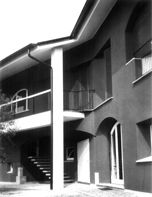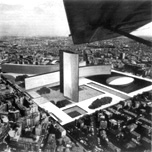projects for Milan and Lumbardy 1962 - 1970
by
VITTORIO MAZZUCCONI
(2/2)
| BACK | HOMEPAGE | ARCHITECTURE | PAINTING | PHILOSOPHY | FOUNDATION |
| B.1.2.2 |
| MEDIOLANUM projects for Milan and Lumbardy 1962 - 1970 by VITTORIO MAZZUCCONI |
(2/2) |
| Houses of Lumbardy 1962 -1966  |
Vittorio Mazzucconi returned to Milan in 1962, commencing his professional activity after many years of studying and settling abroad. On diving into the Italian habitat once more, his immediate interest is seized by the spontaneous architecture of the Paduan Valley. He therefore works on the development of a contemporary architectural language inspired by the themes of the porches, of the brick walls and, mostly, of the roofs, typical of Lumbardy's farmsteads. One must consider that, during this period, the city and its landscape were being ruined continuously by a sad combination of building speculation, rationalism, dreadful regulation and poorly-trained technicians. The love for tradition, for the landscape and, as a consequence, for an architecture of a more human kind, thus found one of its first spokesmen in Mazzucconi, not only in theory but also in the testimony of his works. This approach became afterwards widely shared. |
| Town-plan for Milan 1962 -1965  |
During the same period, alongside this interest for popular architecture, in unison with nature and feeling, Mazzucconi operated in Milan, thinking about how the city could develop in order to really become a metropolis, with architectural works worthy of our times. Expanding his field of thought and researching wider and deeper than before, he came to write the book entitl "The City in the Image and Resemblance of Man" (Hoepli Edition 1967). The text analyses the city on two levels: on a first level, the considerations are more of a historical and philosophical kind, in the quest of the city's soul drowned among the crisis of our present time; on the contrary, the second deals with the reality in which the refound soul accepts, after a profound inner toil, the challenge of transforming the city. This section of the book is centred on Milan, and it relives the history and the relationship of the city with its territory, from its origin to the present day, and even beyond towards a vision of the future. |
| 1967 | Having published his book on Milan, Mazzucconi went to stay
in the United States for one year. He found a civilisation far bigger and
more mature than the small mentality typical of Milan and was struck by
that marvellous difference in scale between the skyscrapers and the little
houses of family life, that he had dreamt for a new Milan. It was the same
diffe- rence existing between reason and feeling, between the power of the
econo- mical world and love in all its forms: for the family, for nature,
for art… that had long inspired his ideal for a city. |
| The inner abode 1967 -1970  |
On returning from the United States, two were the projects that sprung from this experience. After the great vision of the Milan project, the fertile dimension of sentiment and the seed of an inner growth that this feeling brings with it were found again. Both projects were based on the sign of the cross and on the elaborating an ideal way of life and work: the Giovanna's House and the Angioli Furnace. The primer sought an interior abode, that is to say a seat for the soul. This portrays one of Mazzucconi's constant impulses which is partucularly brought on in critical moments or at times when his life seeks new hori- zons. (see also the Capraia's house and the Luogo della Cascata). The second, rather than a research, was an authentic discovery: the Angioli Furnace, which has been Vittorio Mazzucconi's studio for twenty years, was a place of "Grace", that is to say, of fruitful work and devotion. |